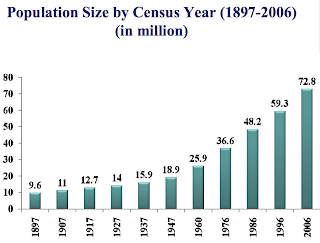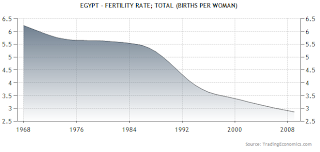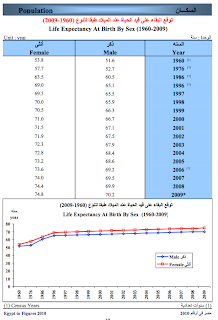
 Since Egypt has been the first item in most newspapers and on most television newscasts for the past week, I thought it was long past time to take a look at the country from an economic perspective since it appears that many of the issues that have created the uprising are economic, most particularly, youth unemployment. What we read in the mainstream media tends to skim the surface of the youth unemployment problem so I thought I’d take a deeper look at one of the largest issues facing Egypt’s future.
Since Egypt has been the first item in most newspapers and on most television newscasts for the past week, I thought it was long past time to take a look at the country from an economic perspective since it appears that many of the issues that have created the uprising are economic, most particularly, youth unemployment. What we read in the mainstream media tends to skim the surface of the youth unemployment problem so I thought I’d take a deeper look at one of the largest issues facing Egypt’s future.One of the great problems facing Egypt has been a very high birthrate, particularly in the 1970s. According to CAPMAS, Egypt is estimated to have 79.74 million people and UNICEF statistics from 2008 show that there were 31.527 million Egyptians under the age of 18, roughly 38 percent of the population. Egypt’s population growth rate has slowed from an annual rate of 2.4 percent in the period from 1970 to 1990 to 1.9 percent from 1990 to 2008. In 2008, the fertility rate was 2.86 births per woman, well down from 6.23 births per woman in 1967 and 4.56 in 1990. Interestingly enough, contraception was used by 60 percent of women.
Here is a graph showing the rapid growth in Egypt’s population over the last century:
Here is a graph showing the drop in birthrate over the past 45 years:
Here is a chart and graph showing how life expectancy at birth has risen over the past 50 years by gender:
This rising birthrate is creating (and will continue to create) rising stress in the country’s employment picture. Here is a population pyramid for Egypt for the years 1986, 1996 and 2006 showing a rapidly growing population in the 1980s. It is these young people that are now forming the “unemployed cohort” as many of them have already reached (or will soon reach) their working years:
From CAPMAS, here is Egypt’s overall unemployment rate by gender over the period from 2006 to 2009 inclusive:
Notice that the country’s over all unemployment rate of 9.4 percent in 2009 was not that far off what was experienced (and is being experienced) in the United States.
One issue that is heavily impacting the overall employment picture in Egypt is demography. The large number of young Egyptians is creating higher unemployment levels among those of working age: over 90 percent of unemployed Egyptians are young people between the ages of 15 and 29. Unemployment in Egypt is largely a product of large numbers of young people entering the job market over a short period of time, preventing the economy from absorbing them. Many young people end up with low wage jobs which prevent them from starting families and purchasing homes. This is leading to a situation where many young Egyptians feel excluded from their own society. Seventy percent of young Egyptians that are unemployed state that they are unemployed simply because work is not available to them.
Here’s a graph showing how labour force participation for non-student youth between the ages of 15 and 29 varies by educational level and gender from the Population Council Survey of Young People in Egypt:
It is interesting to note that among all youth, only 13.4 percent of females participate in the labour force compared to 61.4 percent of males, even when female Egyptians finish schooling. Even among those women that have finished school, on average, only 17.6 percent participate in the labour force compared to 86.3 percent of non-student males. Here’s a graph showing how employment varies by gender and age:
Prior to marriage, 25.1 percent of never-married non-student females participate in the labour force; this drops to 11.9 percent among married women. In comparison, 84.1 percent of never married non-student men participate in the work force; this rises to 95.3 percent once they are married as shown in this graph:
The total youth unemployment rate is 15.8 percent but when discouraged workers are added, the total youth unemployment rate reaches 21.5 percent. The male youth unemployment rates are 12.5 percent and 16.4 percent respectively; women’s youth unemployment rates are 31.7 percent and 42.7 percent respectively. Note that female unemployment generally rises with age, reaching averages of between 30 and 40 percent after the age of 19, dropping only because many of the women marry and drop out of the work force entirely.
Rather unexpectedly, unemployment among Egypt’s youth generally rises with educational level. This is likely due to difficulties in the labour market because of a skills mismatch where employers are not interested in hiring post-secondary graduates because their chosen field of study does not match the employers requirements. Males with a post-secondary institutional education (not university) have a 19 percent unemployment rate and females at the same educational level have a 41.3 percent unemployment rate as shown in this graph:
This phenomenon is contrary to what is experienced in most Western nations where those with a higher level of education generally have a lower rate of unemployment.
As an aside, according to UNICEF, 7 percent of children between the ages of 5 and 14 years were involved in child labour meaning that children between the ages of 12 and 14 did at least 14 hours of economic work per week was undertaken by 7 percent of the cohort and 17 percent of children between the ages of 5 and 14 were married.
When one sees employment statistics like these, it is no wonder that there is a sense of anger and hopelessness among young Egyptians. I wonder how Western youth, most particularly those who have invested in post-secondary education, would behave toward those who are in control of our governments if their economic futures were as bleak.
Click HERE to read more of Glen Asher’s columns
You can publish this article on your website as long as you provide a link back to this page.










Be the first to comment